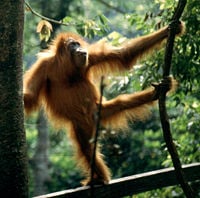Tropical Rainforest Heritage of Sumatra
Coordinates:
| Tropical Rainforest Heritage of Sumatra* | |
|---|---|
| UNESCO World Heritage Site | |

| |
| State Party | |
| Type | Natural |
| Criteria | vii, ix, x |
| Reference | 1167 |
| Region** | Asia-Pacific |
| Inscription history | |
| Inscription | 2004 (28th Session) |
| * Name as inscribed on World Heritage List. ** Region as classified by UNESCO. | |
Tropical Rainforest Heritage of Sumatra comprises three Indonesian national parks on the island of Sumatra — Gunung Leuser National Park, Kerinci Seblat National Park and the Bukit Barisan Selatan National Park. The site is listed under Criteria vii - outstanding scenic beauty; ix- an outstanding example representing significant on-going ecological and biological processes; and x- contains the most important and significant natural habitats for in-situ conservation. UNESCO designated the Tropical Rainforest Heritage of Sumatra a World Heritage in 2004.
Location and Size
The Tropical Rainforest of Sumatra is situated on the middle of Sumatra, Indonesia. It consist of three national parks; Gunung Leuser National Park (GLNP) 8,629.75 square kilometers (3,331.97 sq mi), Kerinci Seblat National Park (KSNP) 13,753.50 square kilometers (5,310.26 sq mi) and Bukit Barisan Selatan National Park (BBSNP) 3,568 square kilometers (1,378 sq mi).[1] The total area of the rainforest is 25,000 square kilometers. The Tropical Rainforest Heritage of Sumatra was chosen because, first, it represents significant area of forests on the island of Sumatra, because of the biodiversity, of lowland and mountain forest. This once vast island of tropical rainforest has been condensed to secluded areas, in the space of 50 years.
Second, the national parks that make up the heritage are all located on the well-known key spine of the Bukit Barisan Mountains, known as the ‘Andes of Sumatra’, and that all around it there are magnificent views.[2] The mountains of each site represent important mountainous backdrops to the established and developed lowlands of Sumatra. The mixture of the stunning Lake Gunung Tujuh (the highest lake in Southeast Asia), the splendour of the giant Mount Kerinci volcano, many small volcanic, coastal and glacial lakes in natural forested settings. This shows the beauty of the Tropical Rainforest Heritage of Sumatra.
Lastly, all three national parks have a very varied habitat and have outstanding biodiversity. Altogether the three sites make up fifty percent of the total plant variety, in Sumatra. At least 92 local common species have been recognized in GLNP. The nomination contains populations of both the world’s largest flower (Rafflesia arnoldi) and the tallest flower (Amorphophallus titanum).[3] The Tropical Rainforest of Sumatra has just recently become apart of the World Heritage List, in 2004.
- PT Amal Tani was owned by the immediate family of the commander of the Indonesian army's territorial military command of the area, KODAM I Bukit Barisan. The principal function of the military partnership is to organize "administrative details" when obtaining permissions to build the roads and other related projects. The director of PT Amal Tani became the executive of the local cooperation unit. The military's unit charitable foundation, Yayasan Kodam I Bukit Barisan, also involved in the project.[4]
ReferencesISBN links support NWE through referral fees
- Kramer, Randall A., Carel van Schaik, and Julie Johnson. 1997. Last stand: protected areas and the defense of tropical biodiversity. New York: Oxford University Press. ISBN 9780195095548.
- Nierenberg, Danielle. 2006. State of the world 2006: a Worldwatch Institute report on progress toward a sustainable society. New York: W.W. Norton. ISBN 9780393327717.
- Tan, Kim H. 2008. Soils in the humid tropics and monsoon region of Indonesia. Books in soils, plants, and the environment. Boca Raton: CRC Press. ISBN 9781420069075.
- Terborgh, John. 2004. Requiem for nature. Washington, D.C.: Island Press [for] Shearwater Books. ISBN 9781559635882.
- Witton, Patrick. 2003. Indonesia. Melbourne: Lonely Planet. ISBN 9781740591546.
External links
Links retrieved December 8, 2008.
- UNESCO World Heritage website
- Wildlife Conversation Society: Saving Rainforests
- The Encyclopedia of the Earth: Tropical Rainforest Heritage of Sumatra, Indonesia
- Post-tsunami assistance for Tropical Rainforest Heritage of Sumatra and Nature Conservation Agency, Aceh Province, Indonesia
- Leuser International Foundation
| |||||||
Credits
New World Encyclopedia writers and editors rewrote and completed the Wikipedia article in accordance with New World Encyclopedia standards. This article abides by terms of the Creative Commons CC-by-sa 3.0 License (CC-by-sa), which may be used and disseminated with proper attribution. Credit is due under the terms of this license that can reference both the New World Encyclopedia contributors and the selfless volunteer contributors of the Wikimedia Foundation. To cite this article click here for a list of acceptable citing formats.The history of earlier contributions by wikipedians is accessible to researchers here:
The history of this article since it was imported to New World Encyclopedia:
Note: Some restrictions may apply to use of individual images which are separately licensed.
- ↑ Patrick Witton, Indonesia (Melbourne: Lonely Planet, 2003), p. 430
- ↑ Kim H. Tan, Soils in the humid tropics and monsoon region of Indonesia. Books in soils, plants, and the environment (Boca Raton: CRC Press, 2008), p. 35
- ↑ Danielle Nierenberg, State of the world 2006: a Worldwatch Institute report on progress toward a sustainable society (New York: W.W. Norton, 2006), p. 125
- ↑ Cite error: Invalid
<ref>tag; no text was provided for refs namedoilpalm